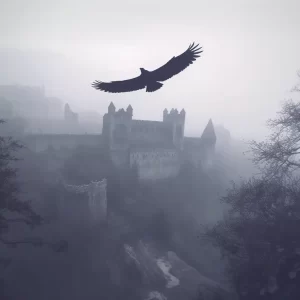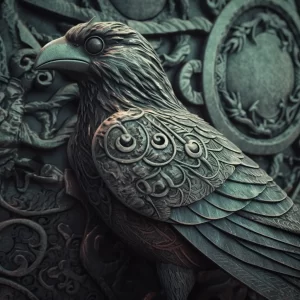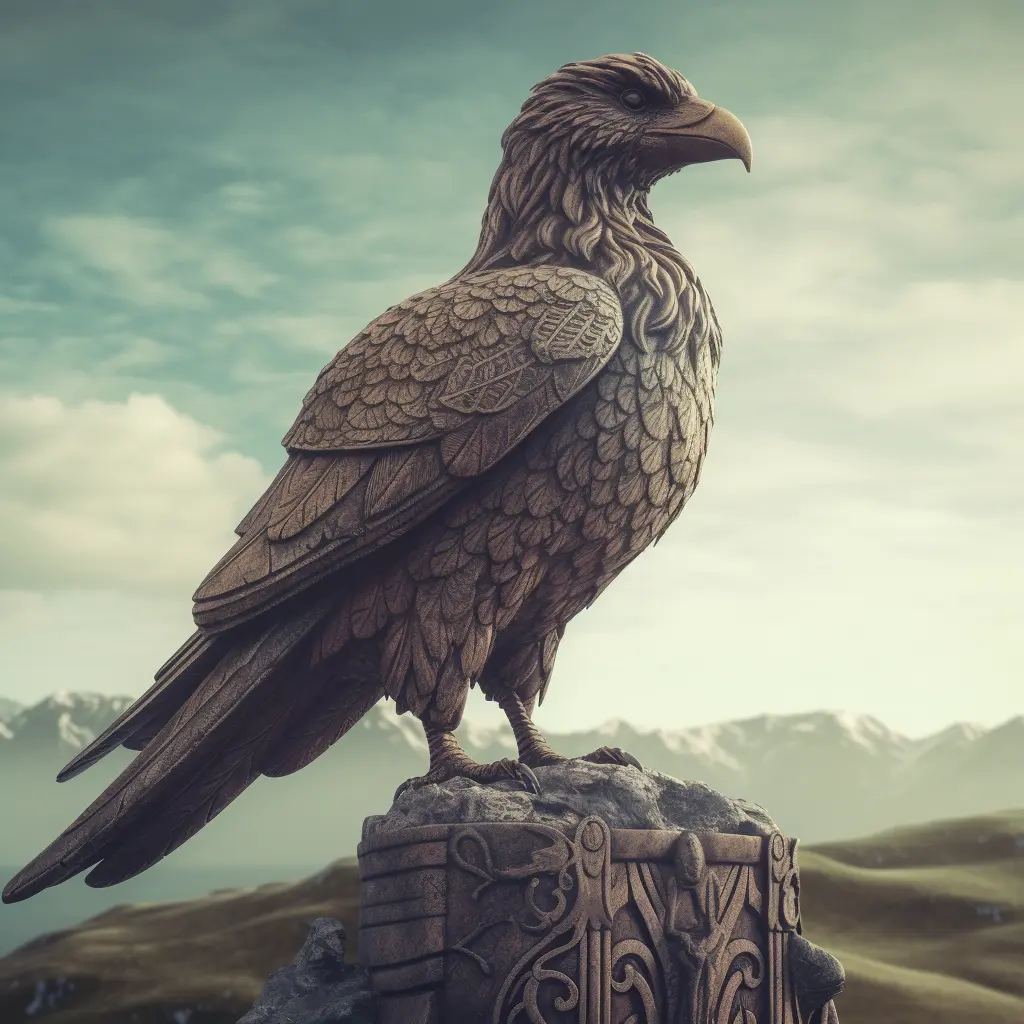Celtic culture has a rich tradition of symbolism and mythology, with Celtic bird mythology playing a significant role in their beliefs. Birds were seen as messengers from the divine, carrying important messages to the people. They were also believed to have healing powers and were used in shamanic practices.
One of the most prominent birds in Celtic mythology is the raven. The raven was revered for its intelligence and was often depicted as a messenger from other worlds. The raven is also associated with the goddess Morrigan, who could transform herself into a raven and inspire warriors to call upon their inner strength. The raven’s magic was believed to reveal the hallowed mystery of healing and was used by both Celtic and Druid Slànaighear (healers) and Native American shamans for long-distance healing.
Other birds in Celtic mythology include the swan, which was associated with love and fidelity, and the eagle, which was seen as a symbol of power and strength. The crane was also an important bird, representing wisdom and longevity. Understanding the significance of these birds in Celtic mythology can provide insight into the culture’s beliefs and values.
History of Celtic Birds
Early Celtic Bird Symbolism
Birds have been a significant part of Celtic culture since ancient times. The Celts believed that birds were messengers from the gods and represented the connection between the spiritual and physical worlds. Early Celtic art depicts birds as symbols of power, freedom, and transcendence.
Druids, the spiritual leaders of the Celts, revered birds for their ability to soar high above the earth and communicate with the divine. They believed that birds could bring messages from the gods and that their songs and flight patterns held hidden meanings.
Celtic Birds in Mythology
Celtic mythology is rich with stories of birds and their significance in the lives of the gods and goddesses. The Morrigan, a renowned Celtic battle goddess, was often depicted as a crow or raven. She was believed to inspire warriors to call upon their inner strength to achieve greatness.
In Welsh mythology, the goddess Rhiannon is associated with birds, particularly the magical birds that sing a sweet lullaby to put people to sleep. The Welsh also believed that the sound of a cuckoo’s call could bring good luck and prosperity.
Corvids, such as ravens and crows, were revered and feared by Celts, Vikings, Greeks, and Romans. They were often depicted as messengers from other worlds and associated with death and the underworld. However, they were also seen as symbols of intelligence and wisdom.
Birds played a significant role in Celtic culture and mythology, representing the connection between the spiritual and physical worlds and the power of communication with the divine.

Celtic Birds in Art and Literature
Celtic art and literature are full of references to birds, which were considered important symbols in Celtic culture. Birds were seen as mediators between the mortal and the divine, and they were often depicted in art and literature as messengers from other worlds. This section will explore Celtic bird motifs in art and birds in literature.
Celtic Bird Motifs in Art
Birds were a popular subject in Celtic art, and they were often depicted in intricate designs and patterns. The artist monks of the Insular style combined Pagan, Mediterranean, and Christian styles in their art, creating a true hybrid invention from ancient times. Some of the most common bird motifs in Celtic art include:
- Raven: The raven was revered and feared by Celts, Vikings, Greeks, and Romans, and it was often depicted as a messenger from other worlds. The raven is also associated with the god Lugh, who was known as the “raven god” in Irish mythology.
- Swan: The swan was a symbol of purity, grace, and beauty in Celtic art. It was often depicted with its neck curved in an S-shape, creating a beautiful, flowing design.
- Eagle: The eagle was a symbol of power and strength in Celtic art. It was often depicted with its wings outstretched, creating an impressive, majestic design.
- Owl: The owl was a symbol of wisdom and knowledge in Celtic art. It was often depicted with its large eyes and distinctive facial features, creating a striking, memorable design.
Celtic Birds in Literature
Birds were also an important symbol in Celtic literature, appearing in myths, legends, and folklore. Some of the most famous examples include:
- The Children of Lir: This is a tragic tale of four children who are turned into swans by their jealous stepmother. They spend 900 years flying around Ireland, singing beautiful songs, before finally being released from their curse.
- The Táin Bó Cúailnge: This is an epic tale of war and heroism, in which the warrior Cúchulainn is accompanied by a flock of magical birds called the “birds of Rhiannon.” These birds help him in his battles, and they are said to have healing powers.
- The Voyage of Bran: This is a mystical tale of a hero who travels to the Otherworld on a magical ship. He is accompanied by a flock of birds who guide him on his journey, including a raven, a swan, and an eagle.
Birds were an important symbol in Celtic culture, appearing in art, literature, and mythology. They were seen as mediators between the mortal and the divine, and they were often depicted as messengers from other worlds.

Frequently Asked Questions
What is the significance of birds in Celtic mythology?
Birds have a significant role in Celtic mythology. They are often seen as messengers between the gods and humans. In Celtic mythology, birds are believed to have a connection to the Otherworld, a mystical realm beyond the physical world. Birds are also associated with the element of air, which is believed to represent the mind and intellect.
What are some common birds in Celtic folklore?
The most common birds in Celtic folklore include the raven, crow, eagle, swan, and magpie. These birds are often associated with different qualities and traits, such as wisdom, prophecy, and magic.
What is the symbolism of the raven in Celtic culture?
The raven is one of the most important birds in Celtic culture. It is often associated with death and rebirth, prophecy, and wisdom. In Celtic mythology, the raven is believed to be a messenger between the gods and humans. It is also associated with the goddess Morrigan, who is often depicted as a shape-shifting raven.
Who is the Celtic goddess associated with birds?
The Celtic goddess associated with birds is Morrigan. She is often depicted as a shape-shifting raven or crow. Morrigan is associated with war, fate, and death. She is also believed to be a guardian of the Otherworld and a protector of the land.
What are some Celtic myths about shapeshifting birds?
One of the most famous Celtic myths about shapeshifting birds is the story of the Children of Lir. In this myth, the children of a king are turned into swans by their jealous stepmother. They spend 900 years as swans before being released from their curse. Another myth involves the goddess Morrigan, who is often depicted as a shape-shifting raven or crow.
What is the meaning behind the magpie in Celtic mythology?
The magpie is often associated with bad luck in Celtic mythology. It is believed that if you see a single magpie, it is a sign of bad luck. However, if you see two magpies together, it is a sign of good luck. Magpies are also associated with thievery and deception in Celtic folklore. In Ireland, people typically greet a single magpie by saying ‘Hello Mr Magpie, how is your wife’. This is meant to negate the bad-luck of seeing a single magpie.


